Table of Contents
OVERVIEW | DISEASES TREATED | TREATMENT | SIDE EFFECTS | Q&A | BROCHURES
"Laser treatment in dogs is increasing dramatically for inflammatory conditions such as dysplasia in the back, knee and elbows. Low power lasers heal deep tissue and joint problems by painlessly penetrate below the skin. More veterinary practices are offering the service as practitioners are finding that lasers can help to treat conditions such as arthritis in small dogs as well as spinal cord injuries. The therapy is safe, brief and painless.
The treatment method is similar to what has been used on humans for 50 years and is now available in about 5,000 veterinary offices. While the therapy is widely in use, more scientific studies are needed."
Overview
Laser therapy is called for when other treatment options that target pain relief have not been effective. The therapy uses an intense beam of light directed into tissues to help reduce swelling, increase circulation and for pain relief. Lasers are referred to as being Class IV therapeutic lasers.
Doses need to be adjusted based on the size of the dog.
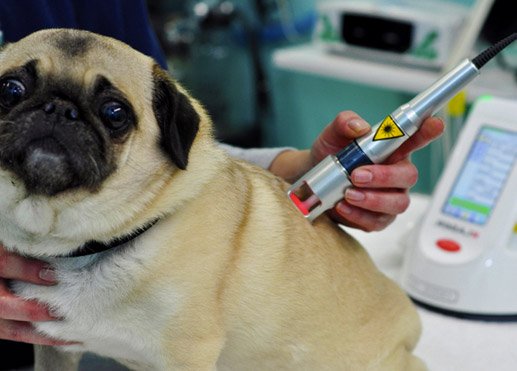
Treatment Advantages:
- Speeds recovery after surgery aiding the regeneration of nerve tissue
- Improves chronic conditions such as arthritis
- Quick and inexpensive
- It is also pharmaceutical free, avoiding side effects associated with potent medications.
- The treatment does not use sedation or fur clipping.
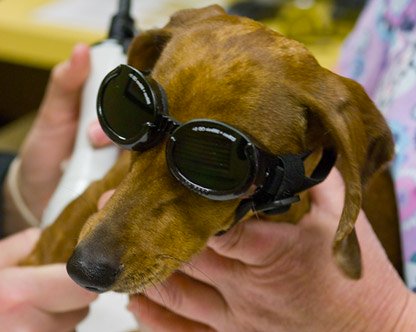
Diseases Treated with Dog Laser Therapy
- Post-surgical injury or trauma
- Ear Inflammation
- Hip dysplasia
- Degenerative joint or disc disease
- Acute lameness
- Arthritis
- Joint pain
- Swelling
- Neuromuscular disease
- Back pain
- Pododermatitis (footpad inflammation)
- Sprains
- Muscle strains
- Tendon injury
- Muscle injury
- Ligament injury
- Open wounds
- Ulcerated and chronic skin wounds
- Pain associated with osteosarcoma (contraindicated in tumorous areas, but knowing risks can be used to relieve pain)
- Hot Spots
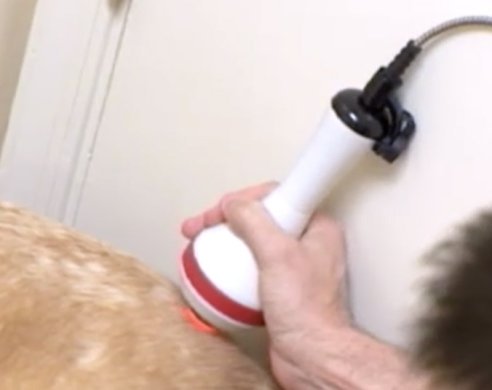
Treatment
Laser treatment is painless and takes only minutes. The laser light is delivered via a non-invasive hand piece. A dog's eyes are directed away from the treatment area or covered for protection (a laser pointed into the eye can cause damage to the retina.)
Many owners are reporting dramatic results such as elimination of limps and an increase in activity levels in treated dogs. Results can be see after the initial treatment. It may take more than one treatment to start visibly seeing results (there could have been some improvement, but did not result in visible clinical improvement.).
Each session takes about 10 minutes on smaller dogs to 1/2 hour for big dogs that are being treated for arthritis. Treatment can be used in conjunction with other methods such as hydrotherapy.
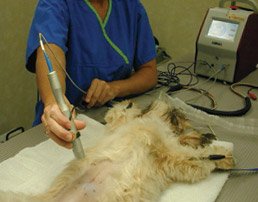
Side Effects
There are few side effects for dog laser therapy. On rare occasions patients being treated for an old injury or pain, the laser treatment may aggravate an area causes pain for a few days followed by healing.
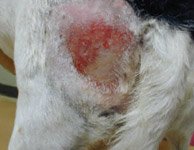
Results and Costs
According to veterinarians at Cornell University, 2/3 of patients see positive results. They recommend that dogs undergo therapy two to three times a week for three weeks. The cost is $35 a session.
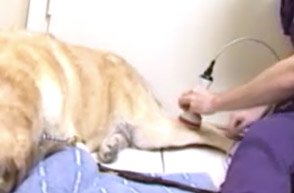
Ask Our Vet A Question, We'll Answer It For Free
Have a Question for our Editors and Readers about Canine Arthritis or have some helpful advice?
Do you have a question about dog laser treatment or therapy? Have an experience with your dog that will help others? Share it! Our editors select several questions a week to answer for free. Just provide your dog's breed, age, sex and medical history.
Please include a picture of any problem areas.
We will do our best to get back to you quickly (depends on how many questions we receive each day). If you do require an immediate response we suggest using this online dog veterinary service that is available now.
Brochures
Free brochures for additional information on the applications of Dog Laser Treatment:boo
For More Information on dog laser therapy:
American Kennel Club Canine Health Foundation
Researched by: Jeff Grill
